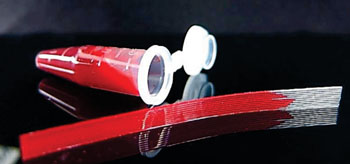Miniaturized Clinical Test Rapidly Detects Antibiotic Resistance
By LabMedica International staff writers
Posted on 07 Sep 2016
A new microfluidic concept for multi-analyte testing in a dipstick format, termed “Lab-on-a-Stick”, that combines the simplicity of dipstick tests with the high performance of microfluidic devices has been developed.Posted on 07 Sep 2016
Lab-on-a-stick tests are ideally suited to analysis of particulate samples such as mammalian or bacterial cells and capable of performing multiple different parallel microfluidic assays when dipped into a single sample with results recorded optically and a portable power-free test for the rapid detection of bacterial resistance to antibiotics has been developed.

Image: The versatile Lab-on-a-stick device that can perform multiplex cellular assays (Photo courtesy of Loughborough University).
Scientists at Loughborough University (UK) and their colleagues carried out different cellular tests to demonstrate the full potential of Lab-on-a-Stick devices for a range of clinical situations. The utility of this new diagnostics format was demonstrated by performing three types of multiplex cellular assays that are challenging to perform in conventional dipsticks: instantaneous ABO blood typing; microbial identification; and antibiotic minimum inhibitory (MIC) concentration measurement.
Anti-microbial resistance was measured with Escherichia coli samples typical of common urinary tract infection (UTIs). UTIs can be hard to treat with antibiotics because antibiotic resistance is so common and laboratory testing takes at least two days. The team demonstrated the advantage of using the microcapillary film which enables 10 different concentrations of antibiotic per sample to be tested with a single test strip.
To identify bacteria, many different tests must be performed on every sample, illustrating again the benefits of microcapillary film which performs 10 tests per test strip. This study demonstrated a four-hour test to distinguish two very closely related bacteria, a harmless laboratory strain of E. coli from Salmonella enterica that causes food poisoning. For ABO blood typing, a simple blood test that takes only two minutes was miniaturized and the results were recorded using an everyday digital camera.
Alexander D. Edwards, PhD, an associate professor and co-author of the study, said, “This is the latest demonstration of our exciting new technology called microcapillary film. What we have done is to develop a low cost way of making thousands of miniature test tubes, so that we can use them for many important applications. Lab-on-a-Stick shows yet again how versatile these microscopic test tubes are.” The study was first published online on June 23, 2016, in the journal Lab on a Chip.
Related Links:
Loughborough University













